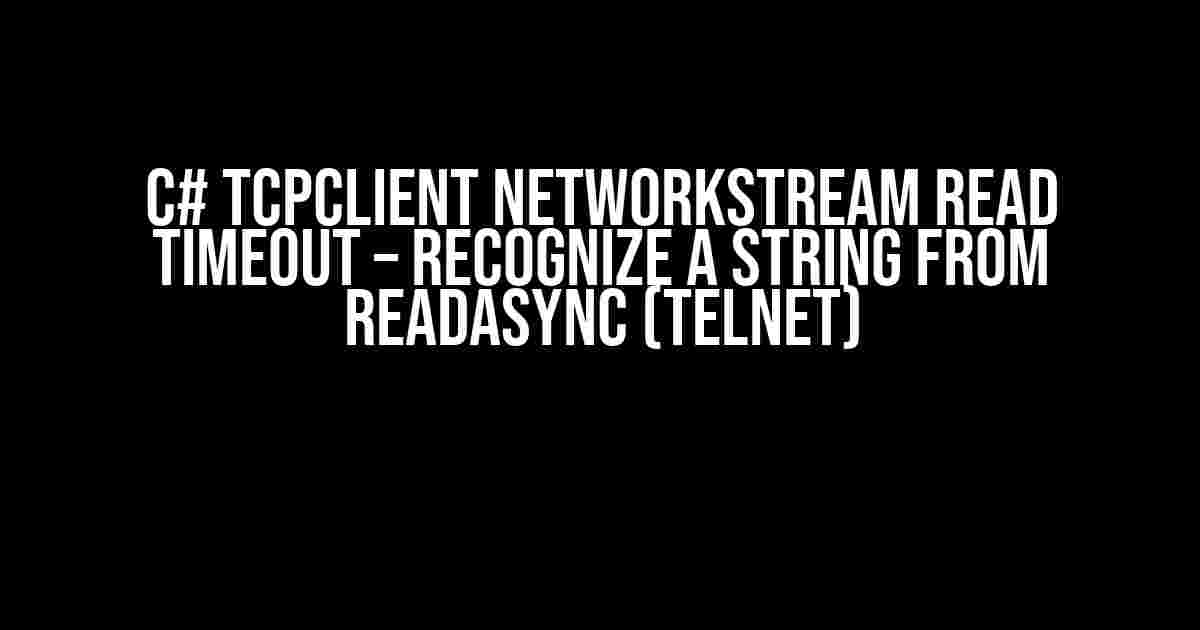Are you tired of getting stuck in the realm of network programming, struggling to understand how to read data from a TcpClient NetworkStream with a timeout? Do you want to know the secrets of recognizing a specific string from the ReadAsync method, especially in the context of Telnet? Look no further! In this comprehensive guide, we’ll take you on a journey to master the art of handling network streams in C#.
Understanding TcpClient and NetworkStream
Before diving into the world of timeouts and string recognition, let’s take a step back and understand the basics of TcpClient and NetworkStream.
TcpClient is a C# class that provides a connection to a TCP service. It’s a wrapper around the underlying socket, making it easier to send and receive data over a network.
NetworkStream, on the other hand, is a class that represents a stream of data flowing over a network. It’s a critical component in network programming, allowing you to read and write data to and from a TcpClient.
The Importance of Read Timeout
Now, let’s talk about read timeouts. In network programming, timeouts are essential to prevent your application from hanging indefinitely, waiting for data that may never arrive.
Imagine you’re building a Telnet client using TcpClient and NetworkStream. You send a command to a Telnet server, and you expect a response. But what if the server takes too long to respond, or worse, doesn’t respond at all? Without a read timeout, your application would hang, causing frustration and potential crashes.
Setting Read Timeout in C#
So, how do you set a read timeout in C#? It’s simpler than you think!
using System.Net.Sockets;
// Create a new TcpClient instance
TcpClient client = new TcpClient();
// Connect to the Telnet server
client.Connect("telnet.example.com", 23);
// Get the NetworkStream from the TcpClient
NetworkStream stream = client.GetStream();
// Set the read timeout to 10 seconds
stream.ReadTimeout = 10000;
In this example, we create a new TcpClient instance and connect to a Telnet server. We then get the NetworkStream from the TcpClient and set the read timeout to 10 seconds using the ReadTimeout property.
Recognizing a String from ReadAsync
Now that we have a read timeout in place, let’s focus on recognizing a specific string from the ReadAsync method. This is where things get interesting!
Assuming you’ve sent a command to the Telnet server and you’re waiting for a response, you want to recognize a specific string, such as “Hello, user!” in the response.
using System.Text;
using System.Threading.Tasks;
// Create a byte array to store the read data
byte[] buffer = new byte[1024];
// Create a StringBuilder to store the received string
StringBuilder receivedString = new StringBuilder();
while (true)
{
// Read data from the NetworkStream asynchronously
int bytesRead = await stream.ReadAsync(buffer, 0, buffer.Length);
// If no data is received, break the loop
if (bytesRead == 0) break;
// Convert the byte array to a string
string receivedBytes = Encoding.ASCII.GetString(buffer, 0, bytesRead);
// Append the received string to the StringBuilder
receivedString.Append(receivedBytes);
// Check if the received string contains the desired string
if (receivedString.ToString().Contains("Hello, user!"))
{
Console.WriteLine("Received the desired string!");
break;
}
}
In this example, we create a byte array to store the read data and a StringBuilder to store the received string. We then enter an infinite loop, reading data from the NetworkStream asynchronously using ReadAsync.
For each iteration, we convert the byte array to a string and append it to the StringBuilder. We then check if the received string contains the desired string using the Contains method. If it does, we exit the loop and print a success message to the console.
Handling Errors and Disconnections
Error handling is crucial in network programming. What if the Telnet server disconnects or an error occurs during data transmission?
To handle errors and disconnections, you can use try-catch blocks and check for specific exceptions, such as SocketException or IOException.
try
{
// Read data from the NetworkStream asynchronously
int bytesRead = await stream.ReadAsync(buffer, 0, buffer.Length);
// If no data is received, break the loop
if (bytesRead == 0) break;
}
catch (SocketException ex)
{
Console.WriteLine("Socket exception occurred: " + ex.Message);
break;
}
catch (IOException ex)
{
Console.WriteLine("IO exception occurred: " + ex.Message);
break;
}
In this example, we wrap the ReadAsync call in a try-catch block, catching SocketException and IOException. If an exception occurs, we print an error message to the console and exit the loop.
Best Practices and Conclusion
Before we conclude, here are some best practices to keep in mind when working with TcpClient and NetworkStream:
- Always set a read timeout to prevent your application from hanging indefinitely.
- Use asynchronous methods, such as ReadAsync, to avoid blocking and improve overall performance.
- Handle errors and disconnections gracefully using try-catch blocks and exception handling.
- Use StringBuilder or other efficient string concatenation methods to build received strings.
In conclusion, recognizing a string from ReadAsync in a TcpClient NetworkStream with a timeout is a critical skill in network programming. By following the instructions and best practices outlined in this guide, you’ll be well-equipped to handle network streams like a pro and build robust Telnet clients in C#.
| Method | Description |
|---|---|
| ReadAsync | Reads data from the NetworkStream asynchronously. |
| GetStream | Gets the NetworkStream from the TcpClient. |
| ReadTimeout | Sets the read timeout for the NetworkStream. |
Remember, practice makes perfect. Experiment with different scenarios, and don’t be afraid to try new things. With time and effort, you’ll become a master of network programming in C#!
Frequently Asked Question
Get ready to dive into the world of C# TcpClient NetworkStream read timeout and recognize strings from ReadAsync (Telnet) like a pro!
What is the purpose of TcpClient in C#?
TcpClient is a C# class used to connect to a remote host using TCP (Transmission Control Protocol). It provides a way to send and receive data over a network connection.
How do I set a read timeout for a TcpClient in C#?
You can set a read timeout for a TcpClient in C# using the GetStream().ReadTimeout property. For example, tcpClient.GetStream().ReadTimeout = 1000; sets the read timeout to 1 second.
What is the difference between Read and ReadAsync in C#?
The main difference between Read and ReadAsync is that Read is a synchronous method that blocks the calling thread until the operation is complete, whereas ReadAsync is an asynchronous method that returns a Task that represents the operation. ReadAsync is generally preferred for I/O-bound operations to avoid blocking the UI thread.
How can I recognize a specific string from ReadAsync in C#?
To recognize a specific string from ReadAsync, you can use a loop to read the byte array returned by ReadAsync and convert it to a string using Encoding.GetString(). Then, use string.Contains() or regex to search for the desired string.
What is Telnet and how is it related to TcpClient?
Telnet is a protocol used for remote login and command-line communications. It uses TCP as the transport layer protocol. When using TcpClient to connect to a Telnet server, you can send and receive data using the ReadAsync and WriteAsync methods, allowing you to interact with the Telnet server programmatically.
I hope this FAQ helps you master the art of using TcpClient and NetworkStream in C#!


